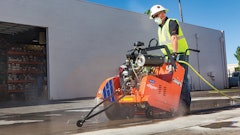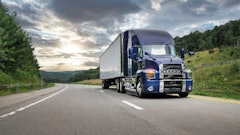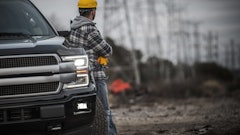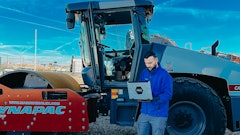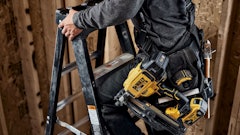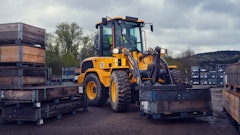
Thermoplastic has been used for pavement striping since the 1950s and remains popular due to its durability and reflective characteristics. The product is more durable than paint because it actually bonds with asphalt and imbedded beads keep “revealing” as the material wears down.
Because it is applied at 400 degrees F, anyone working around thermoplastic needs to take special care. Among safety precautions, David Kautz, thermoplastic sales and service representative for MRL Equipment indicated that wearing protective gear is an absolute necessity. So, too, is having a five-gallon container of water on the job site. “The water will cool the burn, but material manufacturers direct anyone in contact with hot thermoplastic to seek medical attention,” he pointed out.
The bonding characteristic that make thermoplastic so effective in striping, makes it especially harmful to the skin. Because of this potential danger, MRL and other manufacturers of thermoplastic striping equipment reiterate how important safety training is for operating their equipment.
“When working around something as hot as thermoplastic caution takes top priority,” said Marvin Mayle, M-B equipment specialist, “The heated material will splash like water. Should it get on your skin, it will inflict third degree burns.”
Added Tim Wehner, Global Product Marketing Manager for Graco , “After coming in contact with thermoplastic, the last thing one wants to do is touch or otherwise swipe the burned area. Doing so will spread the burn. Safety is always number one, and material that is 400 degrees F can be very dangerous if not handled properly.”
But it’s not just the material that can cause injury, he emphasized. “Thermoplastic is hot, but so too is the equipment that melts and applies it. Touching or otherwise brushing up against the equipment without the proper clothing can result in a serious burn.”
Manufacturers direct operators to be safety conscious because safety is their top priority. With proper training and operation chances of coming in contact with thermoplastic are greatly reduced. Still accidents happen. It’s 110 degrees F outside and someone may think that it’s too hot outside for wearing a long-sleeve shirt and long pants, or a crew member acts out of curiosity, “I wonder just how hot that stripe is.”
If for some reason, the thermoplastic gets over cooked, it will make it not only hotter than normal but also more liquid and more susceptible to splashing, all the more reason to wear the proper clothing at all times.
With that said, Kautz, Mayle, and Wehner offer the following safety tips for anyone operating a thermoplastic striper:
Tip number one. Receive proper training. Read the Operator’s Manual and learn from someone with experience prior to operating the equipment.
Tip number two. Routinely inspect equipment. Check fuel lines, connections, and other components daily.
Tip number three: Wear protective gear, e.g., long-sleeve cotton shirt (cotton won’t melt like polyester), long pants, leather gloves, and leather boots. When transferring material be sure to include welder type sleeves or gloves, along with a face shield.
Tip number four: Keep a five-gallon water cooler at the job site. If someone comes in contact with thermoplastic, immediately apply water to the area to reduce the temperature.
Tip number five: Make sure vehicles are equipped with a first aid burn kit. Even so, material manufacturers direct those who come in contact with thermoplastic to seek medical attention.
Tip number six: Avoid having unnecessary personnel standing nearby when transferring material from a pre-melter to the hand liner. The process should only involve two people, one at the valve on the pre-melter and one at the applicator.
Tip number seven: Keep the two-people rule when cleaning the lines on a truck-mounted striper: one person at the exit point (the gun) and another running the valve on the truck.
Tip number eight. Never transport a hand liner that contains heated thermoplastic. Be sure the unit is secured and empty.
Based in Madison, WI, Rod Dickens is a freelance writer specializing in the construction industry.





